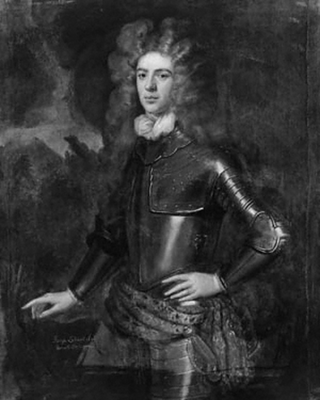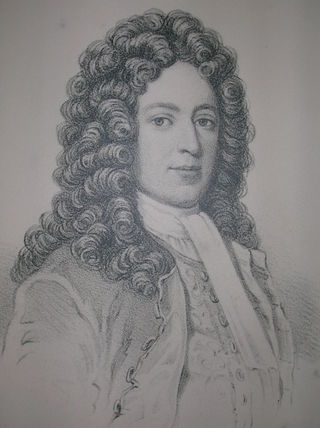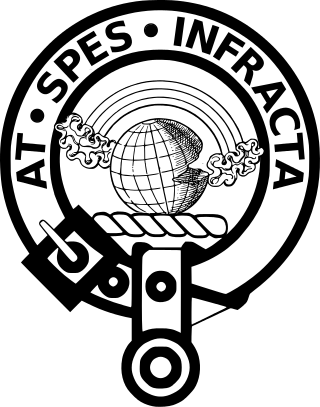
The title Earl of Carnwath is a title in the Peerage of Scotland, created together with the subsidiary title of Lord Dalzell and Liberton, on 21 April 1639 for Robert Dalzell, 2nd Lord Dalzell. His father, Sir Robert Dalzell, had been raised to the Peerage as a Lord of Parliament when he was created Lord Dalzell on 18 September 1628, also in the Peerage of Scotland. The titles refer to Carnwath in Lanarkshire, and Liberton in Edinburgh. The surname of Dalzell is pronounced dee-EL.

Sir George Lockhart of Lee, of Carnwath, South Lanarkshire, also known as Lockhart of Carnwath, was a Scottish writer and Jacobite politician who sat in the Parliament of Scotland from 1702 to 1707 and as a Tory in the House of Commons from 1708 to 1715. He was a member of the Commission on the Union before 1707 but acted as an informant to his Jacobite colleagues and later wrote an anonymous memoir of its dealings. He supported the Stuart cause in the Jacobite rising of 1715.
Walter Aston, 3rd Lord Aston of Forfar was the eldest son of Walter Aston, 2nd Lord Aston of Forfar, and his wife Lady Mary Weston, daughter of Richard Weston, 1st Earl of Portland. He is best remembered today as a fortunate survivor of the Popish Plot.

Sir William Lockhart of Lee (1621–1675), was a Scottish soldier and diplomat who fought for the Covenanters during the 1638 to 1651 Wars of the Three Kingdoms. Following Royalist defeat in the 1642 to 1647 First English Civil War, Lockhart took part in negotiations between Charles I and Scottish Engagers, who agreed to restore him to the English throne.

Alexander Seton Montgomerie, 9th Earl of Eglinton was a Scottish peer, lord of the Eglinton Estate.

Carnwath is a moorland village on the southern edge of the Pentland Hills of South Lanarkshire, Scotland. The village lies about 30 mi (50 km) south of both Edinburgh and Glasgow. It is bounded by the North Medwyn and South Medwyn watercourses.

John Hay, 2nd Marquess of Tweeddale PC was a Scottish nobleman.

Clan Douglas is an ancient clan or noble house from the Scottish Lowlands.

The House of Burnett is a Lowland and Border Scottish family composed of several branches. The Chief of the Name and Arms of Burnett is James Comyn Amherst Burnett of Leys.
James Lockhart of Lee and Carnwath, Count Lockhart-Wishart (Wischeart) of the Holy Roman Empire was a Scottish aristocrat with a successful military career.

Clan Hope is a Scottish clan of the Scottish Lowlands.

Clan Lockhart is an ancient family from the Scottish Lowlands.

Sir George Lockhart of Carnwath was a Scottish advocate, judge and commissioner to parliament who was murdered.
William Douglas, 1st Marquess of Douglas and 11th Earl of Angus (1589–1660) was a Scottish nobleman.

Sir Symon Locard, 2nd of Lee (1300–1371) was a Scottish knight who fought in the Wars of Scottish Independence. According to Lockhart family tradition, he accompanied Sir James Douglas in their curtailed attempt to carry the heart of Robert the Bruce to the Holy Land in 1330.

Lee Castle, also known as The Lee, is a castellated mansion in Auchenglen, a branch of the Clyde Valley in South Lanarkshire, Scotland. It is located 1.5 kilometres (0.93 mi) south of Braidwood, and 4 kilometres (2.5 mi) north-west of Lanark. Lee was the seat of the Lockharts of Lee from its establishment in the 13th century until 1919, though the present house is the result of rebuilding in the 19th century.
Sir James Lockhart, Laird of Lee was a Scottish courtier, politician and judge, and a royalist commander of the Wars of the Three Kingdoms.
Sir John Hope, Lord Craighall (1605?–1654) was a Scottish judge.
Sir George Auchinleck, Lord Balmanno MP (c.1560–c.1640) was a 16th/17th century Scottish politician, judge and Senator of the College of Justice.

George Douglas of Parkhead,, was a Scottish landowner, mining entrepreneur, Provost of Edinburgh, and Keeper of Edinburgh Castle.














